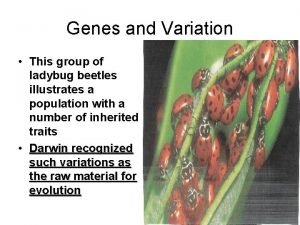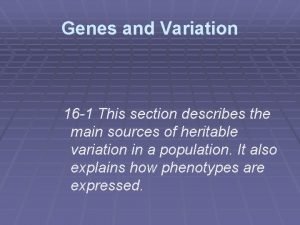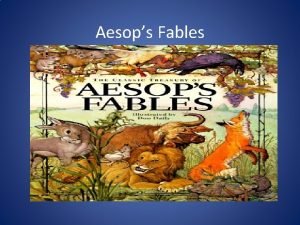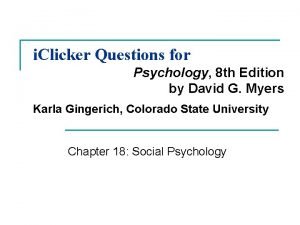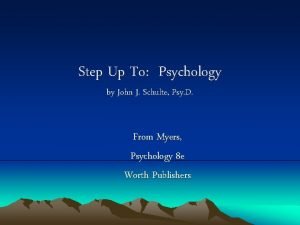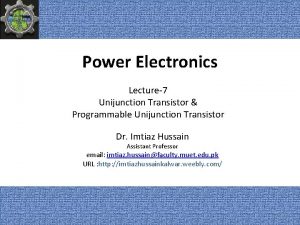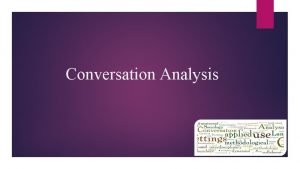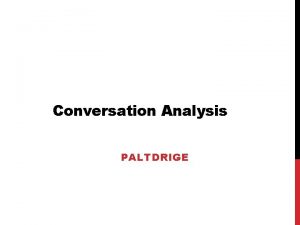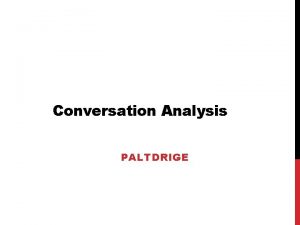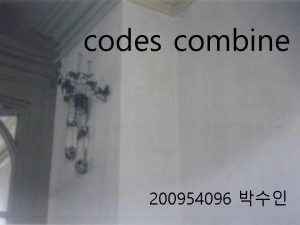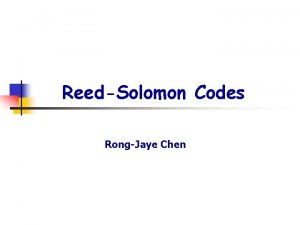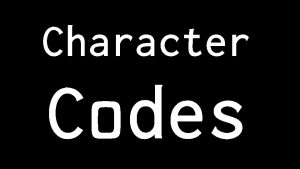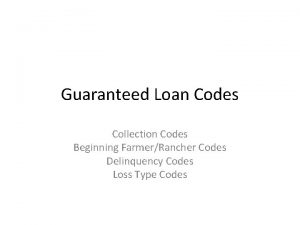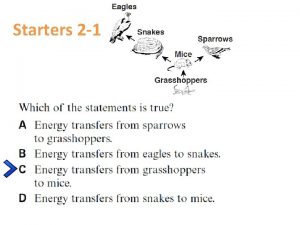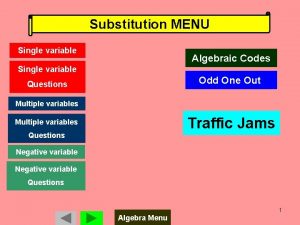Conversation Starters 1 Typically a single gene codes
















- Slides: 16

Conversation Starters 1. Typically, a single gene codes for _____. 2. What do you think might be the function of a “repressor” protein? 3. How does RNA polymerase know where to start transcription? 4. What is lactose?

Gene Regulation in Prokaryotes: Operons Modified with permission from a powerpoint originally from Mrs. Jenn Boyd, Westlake High School

I. Prokaryotic Gene Regulation A. What is gene regulation? 1. Gene regulation: ability of an organism to control which genes are transcribed in response to the environment. B. Why is regulating genes important? 1. Consider: Why would you want to make certain enzymes only at certain times? What benefit is there to doing that? 2. Maximize energy usage!

I. Prokaryotic Gene Regulation C. How do prokaryotes regulate which genes are expressed? 1. Operon: section of DNA that contains the genes for proteins needed for a specific metabolic pathway. NOTE: Operons are in prokaryotes only!!!! What is a prokaryote? Example?

II. The Lac Operon A. History of Discovery: 1. Jacob and Monod discovered how genes controlled the break down of lactose in E. coli.

II. The Lac Operon 2. Jacob and Monod noticed: lactose stimulates E. coli to produce 3 enzymes only when lactose is around. 3. How did this happen? ! The E. coli controls the production of these 3 enzymes that are made from 3 genes located right next to each other on the DNA. B. Operon Structure: a. Each gene codes for one enzyme. What type of macromolecule is an enzyme? (carb, lipid, nucleic acid, protein? ) Lac. I I These 3 genes code for enzymes that help break down lactose.

b. Promoter : DNA segment that RNA polymerase binds to in order to start transcription. c. Operator : DNA segment that serves as a binding site for a repressor protein. Lac. I I

II. The Lac Operon C. Baseline: No lactose present – Operon = Repressed Repressor proteins block transcription and prevents protein synthesis from occurring by binding to an operator (binding site). Lac. I region codes for the repressor protein. (continually expressed at a low rate) Repressor protein binds to the operator and blocks RNA polymerase from transcribing the 3 genes.

II. The Lac Operon b. A promoter is a DNA segment that binds to RNA polymerase and promotes transcription. c. An operator is a DNA segment that serves as a binding site for a repressor protein. Repressor protein Lac. I I RNA polymerase

II. The Lac Operon D. Lactose Present: Transcription! 1. When lactose is present : lactose binds to repressor proteins, changes shape of repressor protein Repressor unable to bind to the operator. 2. If the repressor cannot bind: RNA polymerase can transcribe all three genes of the lac operon. m. RNA Lactose is an inducer molecule because it changes the shape of the repressor to induce transcription

QUICK CHECK 1. When lactose is present, some of the lactose molecules bind to what? 2. When lactose is present, is the lac operon activated? (Y/N) 3. When lactose is absent, what binds to the operator? 4. When lactose is absent, is the lac operon activated? (Y/N) Repressor Molecule Operator Repressor + lactose no binding to operator RNA polymerase Promoter

II. The Lac Operon E. Inducible Operon 1. inducible operon: usually OFF unless it is induced (turned on) by specific molecules 2. QUICK CHECK: What is the “inducer”?

Check for Understanding: 1. T/F. The repressor and promoter regions of prokaryotic operons are on the same chromosome. 2. What protein binds to the promoter in prokaryotes? What protein binds to the operator? 3. An inducer inactivates the repressor. What is the inducer in the lac operon?

Modeling Gene Regulation: Lac Operon Working in groups. You will need me to sign your class note sheet when you show me the operons in motion with the puffballs. Notes with a stamp are due the day of the exam (Wednesday).

Use the space on your note sheet to draw the genes and regulatory sites for the lac operon. Draw the operon first, then use the puffballs and modeling materials to show the operon is controlled. lac I CAP Binding site promoter operator lac Z lac Y lac A Repressor: RNA polymerase: Enzymes that break down lactose: Lactose: m. RNA: 2 pieces of yarn. 1 for repressor, 1 for enzymes that break down lactose

Here is what it will look like… When lactose is absent… the repressor is where? So can RNA polymerase transcribe lac Z, Y or A? (Y/N? ) lac I CAP Binding site promoter operator lac Z lac Y lac A Blocked!!! Repressor: RNA polymerase: Enzymes that break down lactose: Lactose: m. RNA: 2 pieces of yarn. 1 for repressor, 1 for enzymes that break down lactose
 Gene by gene test results
Gene by gene test results Chapter 17 from gene to protein
Chapter 17 from gene to protein Bible conversation starters
Bible conversation starters Congratulations expression
Congratulations expression Single-gene trait
Single-gene trait Section 16-1 genes and variation
Section 16-1 genes and variation Single instruction single data
Single instruction single data Waiting line management system
Waiting line management system Sisd processor
Sisd processor Where did invaders typically enter india from
Where did invaders typically enter india from Electrode holder preventive maintenance
Electrode holder preventive maintenance A short story typically with animals as characters
A short story typically with animals as characters Field research techniques
Field research techniques Webmail is typically a free service.
Webmail is typically a free service. Although frieda is typically very reserved as
Although frieda is typically very reserved as 5 year old tammy mistakenly believes
5 year old tammy mistakenly believes Ujt applications
Ujt applications




